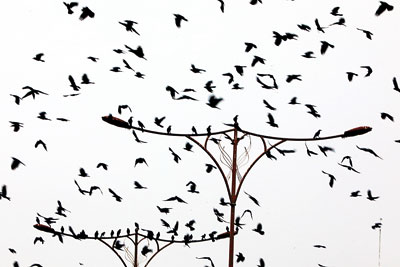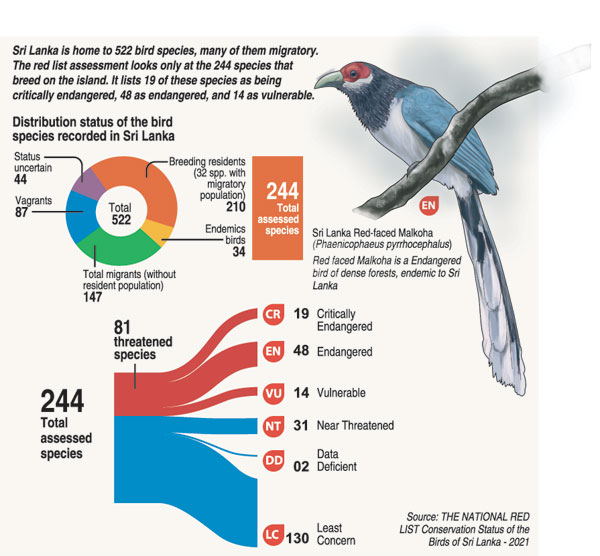News
Protected area network for local birds to help curb extinction
View(s):By Nathara Abeywickrema
The Wildlife Conservation Department, together with the support of the people, intends to run a protected area network mainly aiming to conserve bird species that have recently been listed as endangered.
Habitat loss or degradation is the major cause of endangerment for Sri Lankan birds. Nearly all bird species have been affected and are classified as critical, endangered or vulnerable.
Experts say climate-driven changes in habitats are further shrinking the suitable range for already threatened endemic bird populations, particularly in the island’s wet and montane zones.

Sri Lanka is home to 522 bird species, many of them migratory.Pic by M. A. Pushpakumara
Sri Lanka is home to 522 bird species, many of them migratory. The red list assessment looks only at the 244 species that breed on the island. It lists 19 of these species as being critically endangered, 48 as endangered and 14 as vulnerable. Improved standards of living, conservation awareness among local people, better training and infrastructure in forestry departments were fundamental to the success of conservation actions. Conservation efforts needed to be designed in ways which provided possible benefits or compensation for local people and economies.
“Birds are a vital part of our natural heritage. They inspire cultures, religions and nations in many ways, through their beauty, sounds and close links with people. They help define national and local identities in the face of globalisation. Also, conserving birds clearly has great economic benefits. Bird watching is becoming an increasingly popular interest in the country, and there are increasing business opportunities for the recreation and tourism industries, particularly in rural areas,” said Prof. Sampath Seneviratne, a Zoology professor at the University of Colombo’s Zoology and Environmental Sciences Department.
“More data is needed to build on the information already collected, to continue conservation efforts, prioritise the species which need protection, and to better understand the reasons for their high extinction risk, so the most appropriate actions can be taken. Around 80 percent of threatened bird species require baseline surveys to map their population sizes more accurately. Moreover, 50 percent of species require research into ecology, and 20 percent into nature and causes of threats impacting them,” Prof. Seneviratne said.
Scientists have said the best way to protect endangered bird species was to protect the places where they lived. Any bird that lived in a developed area must navigate a landscape full of human hazards. One of the biggest obstacles to wildlife living in developed areas was roads, as they divided habitats. Shooting, trapping or forcing a threatened or endangered bird into captivity was also illegal and could lead to extinction, which was locally minimised in the island.

Purchasing lands to build up private reserves was the new conservation measure being enforced by the Wildlife and Nature Protection Society, the third oldest conservation organisation in the world. The objective of this action was to build up corridors and extend spaces for birds, so their living spaces do not get divided into fragments.
The best way to say that you found the home of your dreams is by finding it on Hitad.lk. We have listings for apartments for sale or rent in Sri Lanka, no matter what locale you're looking for! Whether you live in Colombo, Galle, Kandy, Matara, Jaffna and more - we've got them all!

